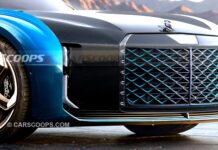Audi has officially confirmed the launch of its long-awaited entry-level electric vehicle (EV), the A3 e-tron, set to arrive in 2026. This follows a strategic shift in the brand’s naming convention, where electric models now share names with their internal combustion engine (ICE) counterparts, marking a departure from its previous system that required EVs to use even-numbered designations.
A Retro-Inspired Design
The A3 e-tron draws inspiration from Audi’s iconic A2 model of the early 2000s, despite being significantly larger than its predecessor. The design features a distinctive “cab-forward” silhouette, reminiscent of the A2, with a low roofline, steeply angled windshield, and short bonnet—all aimed at improving aerodynamics. Other nostalgic elements include a two-piece rear door design (similar to the A2), round flared wheelarches, and a small wing on the rear hatch.
While the front-end styling aligns more closely with current Audi models, the rear section pays homage to the A2. The car’s overall shape also bears a resemblance to the Volkswagen ID.3 and Skoda Borncar concepts, but with a more futuristic twist.
Technical Specifications
The A3 e-tron is expected to be built on the updated MEB+ platform, which Audi shares with other EVs in the Volkswagen Group. This platform supports battery options ranging from 58kWh to 79kWh, delivering an estimated range of up to 400 miles on a full charge.
The vehicle will likely feature a rear-mounted electric motor and battery pack integrated under the floor, ensuring a balanced weight distribution. While details are still under wraps, the design is expected to draw from Audi’s 2019 AI:ME concept car, which was slightly shorter than the current A3 model.
Strategic Shift at Audi
The A3 e-tron marks a significant shift in Audi’s product strategy. The brand is focusing on expanding its reach into the premium segment (C-segment) by eliminating smaller models like the A1 supermini and Q2 crossover. This move positions Audi to compete directly with rivals like Mercedes-Benz and BMW in the mid-range EV market.
Audi CEO Gernot Döllner revealed that the company has re-evaluated its product plans, prioritizing key markets like China and the United States. While some models have been deprioritized, the A3 e-tron remains a cornerstone of Audi’s future lineup.
Conclusion
The A3 e-tron represents Audi’s commitment to evolving its lineup while nodding to its heritage. By blending retro design cues with modern EV technology, the brand aims to capture a broader audience in an increasingly competitive electric vehicle market. As Audi shifts its focus upward, the A3 e-tron could signal the start of a new era for the iconic automaker


























